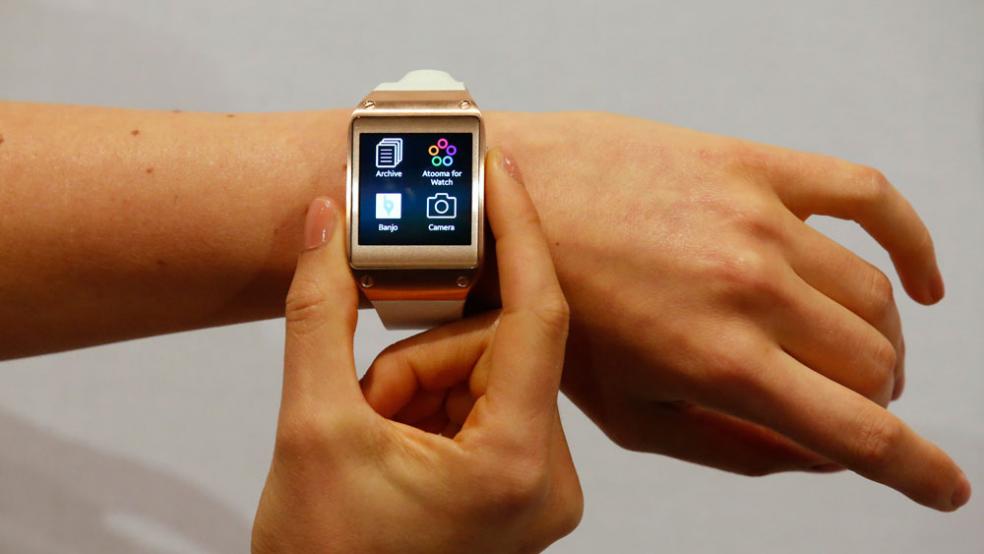I’ve been thinking a lot about smartwatches lately.
Well, thinking about them and wearing them. The recently released Samsung Galaxy Gear, which I've already reviewed, shows promise but ultimately doesn’t last long enough and isn't smart enough for my taste. But... given the choice between the Pebble smartwatch that lasts all week and the Gear that lasts two days, I'd wear the Gear because it has a few more high-tech features, like voice-reply texting.
Years ago, when everyone started looking at their phones to check the time, the wristwatch became a fashion accessory for most people. I still use one to check the time, mostly because I'm too lazy to pull out my phone every 10 minutes.
Related: Why Wall Street Hates the iPhone 5C
Your wrist is an ideal place for a wearable computing device, though. (With apologies to women who generally have thinner wrists: the Gear is likely a few sizes too big and too bulky to be a fashion item.) There's a reason why the wristwatch, invented in 1923, has lasted 90 years. With a quick flick, you glance down and know the time and date instantly - plus the temperature, altitude, and a few other factors if you own a Casio. A wearable device in any other location on the human body would not be quite as convenient.
Unfortunately, smartwatches are still too dumb. To make them more viable in business and for the general populace, a few things need to change.
1. Make them more connected.
For me to really want to start using a smartwatch, it needs to connect to the Wi-Fi network in my office, the fitness tracker on my work-out machine (using Bluetooth 4.0), the heating controls in the hallway. In short, it needs to connect to everything. A smartwatch needs to be the brain center of my daily work life (and personal life).
If the primary use of a smartwatch is to relay text messages (aka the Pebble) then I’ll just keep using my phone. But, provide instant access to my bank account balance and the temperature in the room, not to mention connect me for face-to-face Skype chat, and I’ll keep my phone stashed.
2. Tap into rich data.
The screen size on a smartwatch will always be small - unless someone figures out how to do a Princess Leia hologram. That means it should tap into a rich treasure of data (weather anywhere, financials, contact current location, etc.) but show it in a truncated way. In other words, the displayed data is in short form, but the watch processes large amounts of information quietly and efficiently in the background. Maybe I walk into a meeting and can flick through a bio of each attendee, with a photo to help identify them. Maybe my watch taps into sensors in the building and can warn me about air quality problems or even potential viral infections. The new mantra for smartwatches should be, simple screen notifications, amazing background processing, intense data stores in the back-end.
3. Respond to voice discussions, not commands.
The small size is only limiting, though, for visual data. A smartwatch really needs to be smarter than Google Now and Siri. It should be more like a digital assistant and respond to almost anything, ala the Ivee Alarm Clock. I should be able to say things like "reschedule my meeting for this afternoon" and the watch would know I mean the really important meeting with my boss. Or, I should be able to carry on a conversation about a topic. This should be multifaceted. I might say, "I want to talk about venture capital." The watch would then understand the terms I’m using and provide answers based on Google searches, Quora data, and even my own email archive.
4. Cast an HD image.
I was joking about the Princess Leia hologram - sort of. There are now micro-projectors that cast an HD signal a few feet away that looks bright and clear. Somehow, a company like Texas Instruments should figure out how to make a smartwatch capable of emanating a video image. The Galaxy Gear already snaps photos from the wrist strap; now it needs to show a presentation in HD (without having to draw the shades and turn off every light). There’s an obvious battery issue here but that’s why we call them "smart" watches, right?
Ultimately, the way to make smartwatches more business-friendly is with better connections. A truly smart watch would let me know who is tweeting around me. A smart watch would understand my surrounding; it would function more like a subtle feature I’ve used already on the iPhone 5S that can share photos from an event on Flickr as you post them. In other words, it would be intelligent, specific, and local.
Will it happen? I don’t know. The hardware and software are ready. The two unknowns are whether people are ready for that level of connectivity, and when the world itself will become more connected. (Most meeting spaces barely have a projector and a whiteboard.)
Entrepreneurs, are these challenges you can tackle?
This article originally appeared at Inc.com. Read more at Inc.com:




